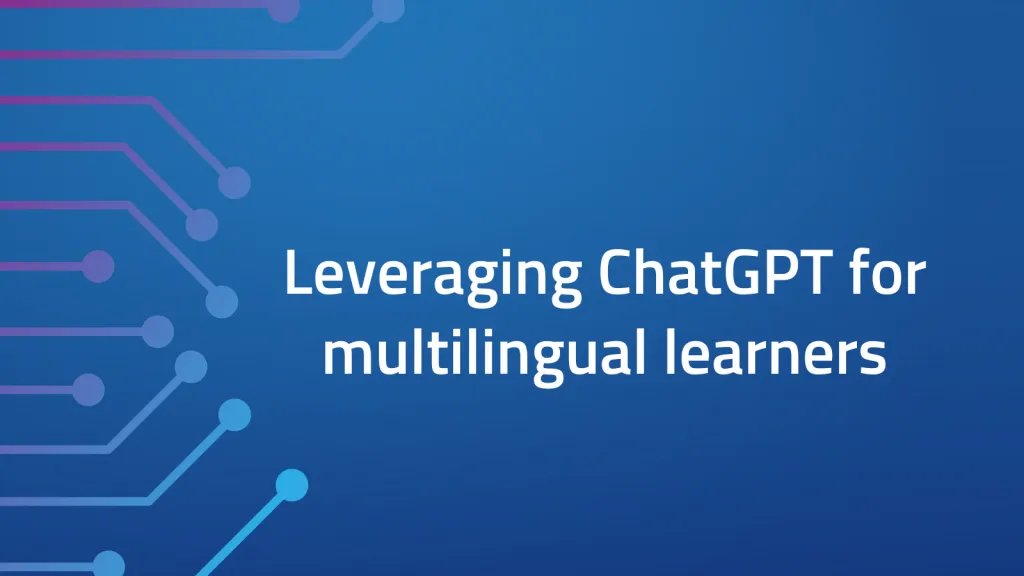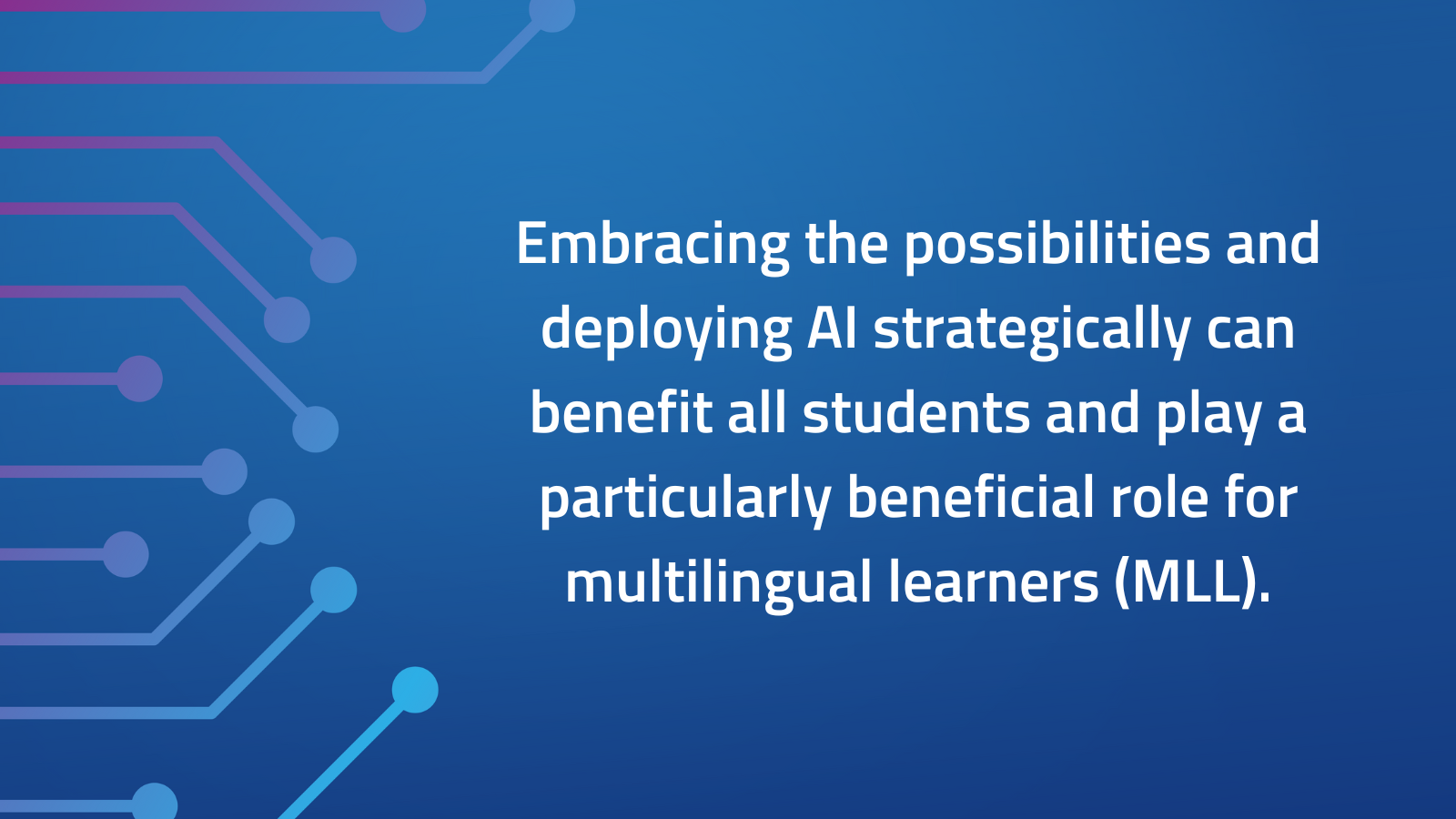Leveraging ChatGPT for multilingual learners


Leveraging ChatGPT for multilingual learners
The K-12 world is abuzz with opinions, both positive and negative, about the threats and opportunities that AI tools like ChatGPT bring to our classrooms. I tend to agree with those who compare this new tool to math calculators. They certainly had an impact when I was growing up and the best teachers I had found ways to leverage their power while ensuring that I had time without them to build my skills independently. The same is true for ChatGPT in today’s classrooms. We can individualize learning by using AI tools to scaffold or support skills like revising, argumentation, visual learning, and goal-setting which is just the beginning.

Unleashing the power of revising and editing
One of the problems cited with ChatGPT is that it’s not always factually accurate or well written. While it may have correct grammar, spelling, and mechanics, the ideas might not be solidly connected or on point. We can take this flaw and turn it into a benefit for MLL writing instruction.
Author Tan Huynh (2016), who specializes in language acquisition and literacy development, created a revision framework that speaks to the importance of revision. He writes that “as literate adults, we know that we have to write badly to write well, and that revising transforms poorly-written texts into well-crafted, intentional ones.”
Revising is a key part of the writing process (MacArthur, 2007). And revising is a particularly powerful tool for multilingual learners (Panofsky et al, 2005). Writing programs include student models to demonstrate specific steps of revising and editing. With ChatGPT it’s possible to instantly generate multiple examples for students to revise. As with many areas of learning in a new language, multilingual learners have the cognitive load of putting their ideas into writing and summoning the right words, grammar, syntax, and usage rules. Giving multilingual students more practice in revising helps them focus on specific language objectives. Research shows that writing scores on English language proficiency tests are often a blocker for students who are otherwise ready for reclassification. By providing rich resources for focused practice on revising, you can provide more intensive work to build this critical aspect of writing.
Developing argumentation skills
Analyzing and writing arguments is an intense and challenging skill, especially for multilingual learners who are developing content and linguistic skills at the same time. ChatGPT can be a useful tool in helping students engage with argumentation. The AI tool can generate several sides of an argument in seconds. With this tool, teachers won’t have to work within the limits of their libraries or reading programs. They can create meaningful topics that are relevant, timely, and motivating for their language learners. And given the known issues with the accuracy of ChatGPT content, students can feel even more empowered to critically question the texts.
With an abundance of examples in hand, multilingual learners can engage in interactive activities to build their ideas and language such as Pro/Con Improv or T-Chart, Pair, Defend. They can then use the ChatGPT-examples, discussions, and notes to draft their own arguments using activities like Tell MORE. Teachers can learn more about the research and best practices for activities like this in the Strategies Fostering Interactions Through Opinions and Debates module.
Creating amplified content
For multilingual learners, learning new concepts in a new language is double the work. Research shows that wide reading builds both vocabulary (Nagy & Herman, 1987) and comprehension (National Reading Panel, 2000). When students read widely, they select and explore texts across a broad variety of topics, genres, and areas of interest. Combining ChatGPT text with a tool like DALL·E 2 to generate AI images could be a game changer. Teachers would be able to help multilingual students exercise their reading and content muscles to build the skills needed to engage in the rigorous and engaging work of academic learning. ChatGPT can even generate text in multiple languages, which can be really impactful in classrooms where the linguistic assets of students do not align with the linguistic assets of their educators.
Goal-setting and guardrailing
“Embrace that challenge” is an easy phrase to write but it’s not as easy to enact in classrooms, especially for multilingual learners who may have less confidence in their language skills. Goals are a great tool to help linguistically gifted students develop a growth mindset and a sense of empowerment in driving their own learning.
While having examples to prompt thinking, talking, and writing can be useful, it’s sometimes best to invite students to think and write without models or examples as frontloading. Engaging MLLs in goal-setting for writing skills and making the use of scaffolds or supports like ChatGPT part of those goals it becomes an explicit and visible tool with guardrails and goals for building independence. It puts the decision into their hands and gives them the confidence to become key partners in decisions about when to leverage AI and when to commit to working independently on drafts. It’s hard to change a dynamic from policing to partnership, but with the right relationships and structures it can unleash incredible results.
Conclusion
School policies are rapidly being formed and revised for how AI like ChatGPT can and should be used. We will continue to learn what the promises and pitfalls of this new technology are, but in the meantime we are excited by the opportunities that these tools can enable. As with any new tool, opportunities are counter-balanced by risks. While revising opportunities may become more readily available, drafting is still a critical step in the writing process and we must be careful that it does not become neglected as students are drawn to the ease of AI-generated work. AI is imperfect in other ways as well. Not only can factual and logic errors appear in AI-generated writing but AI is based on relatively monocultural sources so must be balanced with authentic, culturally, and linguistically-relevant texts. We are at the very beginning of an exciting time and look forward to seeing creative and innovative teachers and learners inspire the field.
A note about AI accuracy and access:
It’s important to keep in mind that the artificial intelligence that underlies tools like ChatGPT is based on material that is published on the internet and in some select books, so issues around accuracy, relevance, and bias do exist. While it was designed to support multilingual users, many argue that it’s still relatively monocultural. Content generated by AI should be accompanied by culturally-rich materials that clearly reflect varied cultures and viewpoints that one might not find in common Wikipedia articles. For instance, while turning an I Notice, I Wonder activity into a ChatGPT prompt might quickly enable a teacher to pursue those authentic questions, care must be taken to check key facts for accuracy.
A great tool can become an impediment if there is too great a reliance on it. All students must learn to draft their own ideas independently without the help of AI like ChatGPT. There are clear times when ChatGPT must be turned off and students must embrace that challenge. Students will not have access to these tools when they take high-stakes writing tests. Even during normal times the tool may not always be accessible. I wanted to use ChatGPT to draft this article but the site was so overwhelmed with users that I was unable to access it.
Bibliography
Huynh, T. (2016, November 4). #12. Star revision: A framework for revising writing in 5 steps. Tan K Huynh. https://tankhuynh.com/a12-using-star-revision-with-ells/
MacArthur, C. (2007). Best practices in teaching evaluation and revision. In S. Graham, C. MacArthur, & J. Fitzgerald (Eds.), Best practices in writing instruction (pp. 141-162). Guilford Press.
Nagy, W. E., & Herman, P. A. (1987). Breadth and depth of vocabulary knowledge: Implications for acquisition and instruction. In M. G. McKeown & M. E. Curtis (Eds.), The nature of vocabulary acquisition (pp. 19–35). Lawrence Erlbaum Associates, Inc.
National Reading Panel. (2000). Chapter 3: Fluency. In Teaching children to read: An evidence-based assessment of the scientific research literature on reading and its implications for reading instruction (NIH Pub. No. 00-4769, pp. 3-1-3-43). National Institute of Child Health and Human Development, National Institutes of Health.
Panofsky, C., Pacheco, M., Smith, S., Santos, J., Fogelman, C., Harrington, M., & Kenney, E. (2005). Approaches to writing instruction for adolescent English language learners: A discussion of recent research and practice literature in relation to nationwide standards on writing. The Education Alliance at Brown University. https://doi.org/10.26300/6zqk-se51